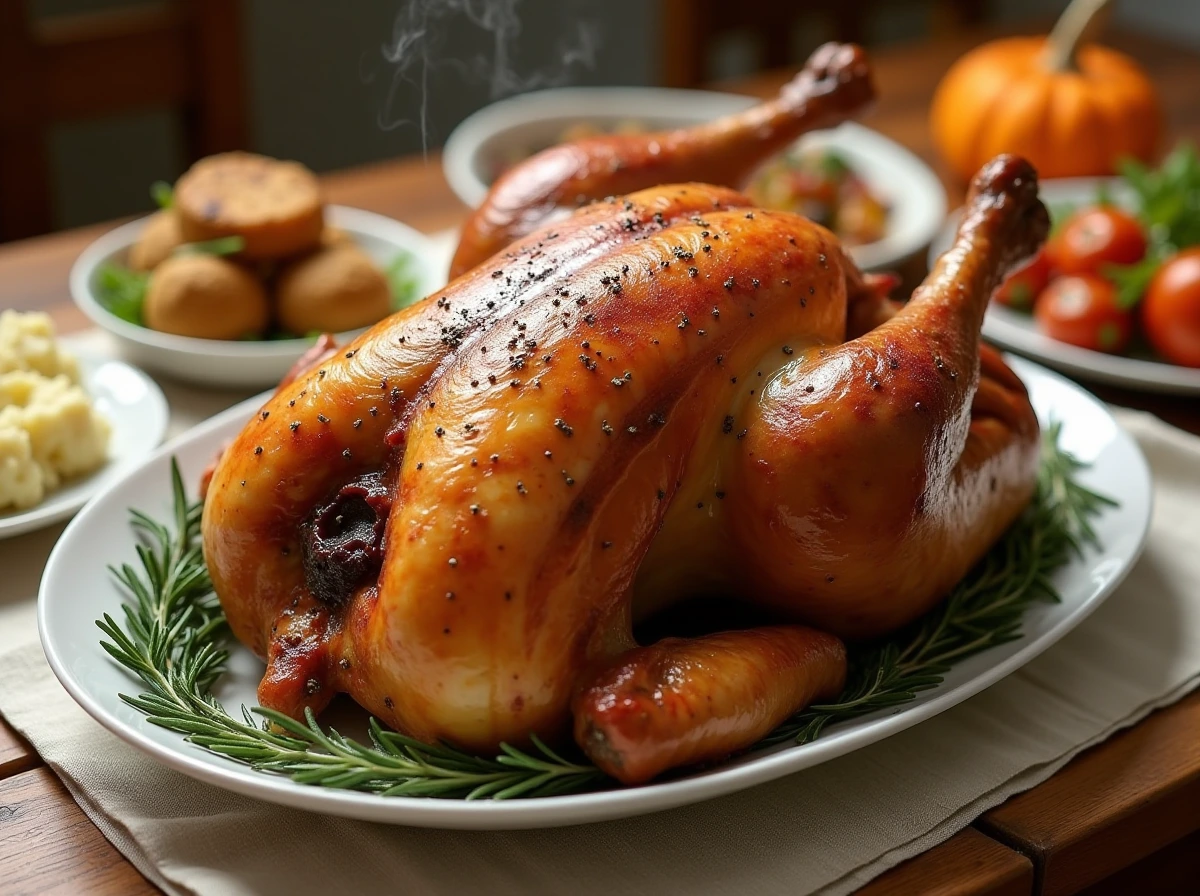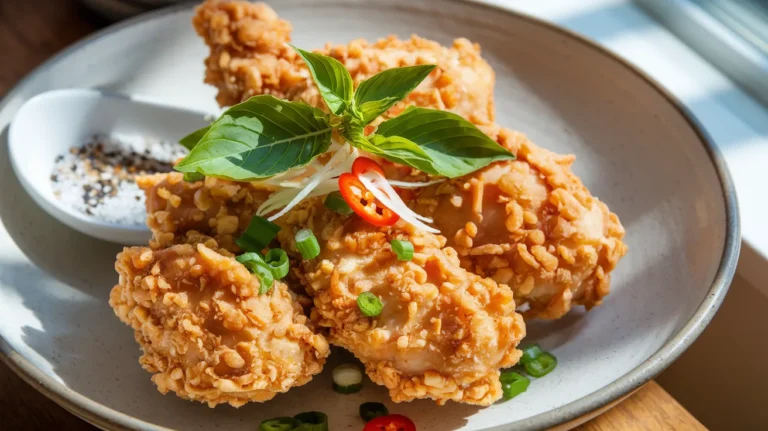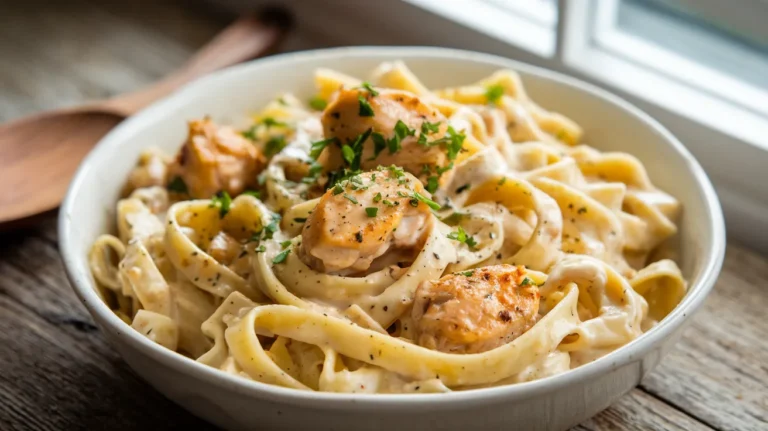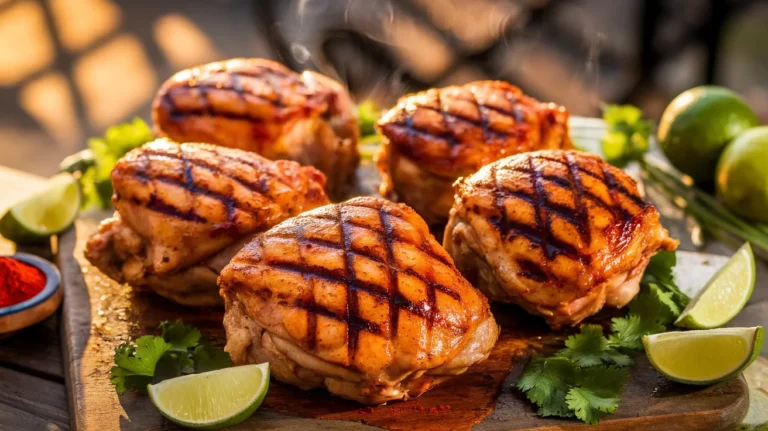- Crispy golden skin with minimal prep work
- Juicy, tender meat that stays moist
- Beginner-friendly 8-10 pound turkey – ideal for 4 people
- Complete in under 3 hours with easy-to-follow timing
Why Learning How to Cook a Turkey Is Easier Than You Think
First time cooking a turkey? Don’t worry. Many first-timers feel intimidated by this classic centerpiece.
The good news is that how to cook a turkey doesn’t require culinary school training or fancy techniques.
This beginner’s guide to how to cook a turkey breaks down every single step with clear instructions designed for a small gathering of four people. You’ll learn exactly how to cook a turkey that’s juicy inside with perfectly crispy skin.
No complicated methods. No chef terminology. Just straightforward directions for a beautiful turkey that will impress everyone at your table.
Let’s make your first turkey experience a delicious success.
Nutrition Facts per Serving
| Nutrient | Amount | % Daily Value |
|---|---|---|
| Calories | 385 | – |
| Protein | 58g | 116% |
| Fat | 14g | 18% |
| Saturated Fat | 4g | 20% |
| Carbohydrates | 0g | 0% |
| Sodium | 420mg | 18% |
| Potassium | 620mg | 13% |
| Iron | 3mg | 17% |
What You’ll Need for How to Cook a Turkey
Ingredients
| Ingredient | Amount | Notes |
|---|---|---|
| Whole turkey | 8-10 pounds | Fresh or fully thawed |
| Butter | 8 tablespoons (1 stick) | Unsalted, softened |
| Garlic | 4 cloves | Minced |
| Fresh herbs | 2 tablespoons each | Rosemary, thyme, sage (minced) |
| Lemon | 1 | Cut into quarters |
| Salt | 1 tablespoon | Kosher salt preferred |
| Black pepper | 2 teaspoons | Freshly ground |
| Onion | 1 medium | Quartered |
| Carrot | 2 medium | Roughly chopped |
| Celery | 2 stalks | Roughly chopped |
| Chicken broth | 2 cups | Low-sodium |
Equipment List
| Tool | Purpose |
|---|---|
| Roasting pan | With rack to elevate turkey |
| Meat thermometer | Digital preferred |
| Kitchen twine | For trussing (optional) |
| Aluminum foil | To cover parts that brown too quickly |
| Basting brush | For applying butter mixture |
| Paper towels | For drying turkey |
| Cutting board | Large enough for carving |
| Sharp knife | For carving |
| Measuring cups/spoons | For accurate measurements |
Possible Substitutions
- No fresh herbs? Use 2 teaspoons each of dried herbs instead
- No roasting rack? Make a ring of aluminum foil or use chopped vegetables
- No butter? Olive oil works too (¾ cup)
- If you enjoy homemade KFC chicken, you might like adding ½ teaspoon of paprika to your turkey seasoning for extra flavor
Beginner’s Guide: How to Cook a Turkey Step-by-Step
Prep Time: 30 minutes
Cook Time: 2-2.5 hours
Total Time: 3 hours
Preparation Phase (Day Before & Day Of)
- Thaw your turkey properly (if frozen)
- Place frozen turkey in refrigerator 24 hours for every 4-5 pounds
- For an 8-10 pound turkey, this means 2 days of thawing time
- Never thaw at room temperature (safety risk)
- Check if fully thawed by making sure there are no ice crystals inside cavity
- Remove turkey from refrigerator
- Take turkey out 1 hour before cooking
- Let it reach room temperature for even cooking
- Keep it wrapped during this time
- Preheat your oven
- Set to 425°F (220°C)
- Make sure rack is in lower-middle position
- Allow at least 20 minutes for full preheating
- Prepare the herb butter
- Take butter out 30 minutes before to soften
- Finely mince garlic with a sharp knife (or use pre-minced)
- Finely chop fresh herbs until you have 2 tablespoons of each
- In a small bowl, mix softened butter, minced garlic, and herbs
- Add 1 teaspoon salt and 1 teaspoon pepper
- Mix until well combined and smooth
- Set aside at room temperature
- Prepare the vegetables
- Peel and quarter the onion
- Wash, peel, and roughly chop the carrots into 2-inch pieces
- Wash and chop celery into 2-inch pieces
- Set aside half for cavity, half for roasting pan
Getting the Turkey Ready
- Prepare the turkey
- Remove turkey from packaging (in sink to catch juices)
- Remove giblets and neck from cavity (usually in paper or plastic bag)
- Check both main cavity and neck cavity for giblets
- Save giblets for gravy if desired, or discard
- Rinse turkey inside and out under cold water (optional)
- Pat completely dry with paper towels (very important!)
- Use multiple paper towels until skin is completely dry
- Place turkey on cutting board or in roasting pan
- Season the turkey cavity
- Cut lemon into quarters
- Sprinkle remaining salt and pepper directly inside cavity
- Rub it around with your hands to distribute evenly
- Place quartered lemon, half the onion quarters, and a few sprigs of fresh herbs inside cavity
- Don’t overstuff – air needs to circulate
- Apply herb butter – under skin
- Starting at the neck end, gently slide your fingers between the skin and breast meat
- Be careful not to tear the skin
- Create a pocket between skin and meat
- Take half the herb butter and push it under the skin
- From the outside, massage butter to distribute evenly
- Try to reach as much of the breast as possible
- Apply herb butter – outside
- Take remaining herb butter
- Using clean hands or a basting brush, coat entire outside of turkey
- Cover all exposed skin including back, legs, and wings
- Pay special attention to breast area
- Make sure coverage is even and thorough
- Position the turkey
- Place turkey breast-side up on roasting rack in pan
- Tuck wing tips behind shoulders (like turkey is putting arms behind head)
- If wing tips won’t stay tucked, secure with small skewers
- Optional: tie legs together with kitchen twine (cross ankles, wrap twine, tie knot)
- Make sure turkey sits securely and won’t tip over
- Add vegetables to pan
- Scatter remaining chopped carrots, celery, and onion quarters in bottom of pan
- Arrange in even layer under the rack
- Pour 1 cup chicken broth into bottom of pan (not over turkey)
- These vegetables will flavor the drippings for gravy
Cooking Phase – How to Cook a Turkey to Perfection
- Start with high heat
- Place turkey in preheated 425°F oven
- Set timer for exactly 30 minutes
- This high heat helps crisp and brown the skin
- No need to open oven during this time
- Reduce temperature
- After 30 minutes, lower heat to 325°F (165°C)
- No need to open oven door when changing temperature
- Keep turkey in oven during temperature change
- Calculate remaining cook time
- For an 8-10 pound turkey:
- 8 pounds = approximately 1 hour 45 minutes additional time
- 9 pounds = approximately 2 hours additional time
- 10 pounds = approximately 2 hours 15 minutes additional time
- Set timer for 30 minutes less than calculated time (for temperature checks)
- For an 8-10 pound turkey:
- Baste occasionally
- Every 30 minutes, quickly open oven door
- Using basting brush or turkey baster, collect juices from pan
- Brush or squirt juices over turkey surface
- If pan looks dry, add ½ cup more broth
- Try to complete basting in under 1 minute to maintain oven temperature
- Close oven door completely after each basting
- Monitor browning
- Check color of turkey during basting
- If breast or any parts brown too quickly, loosely cover with foil
- Tear piece of foil large enough to cover browning areas
- Loosely tent foil over those areas only
- Can be removed in last 30 minutes for final crisping
- Check for doneness
- Begin checking temperature at 30 minutes before estimated finish time
- Insert meat thermometer into thickest part of inner thigh
- Avoid touching bone with thermometer (gives false reading)
- Temperature should reach 165°F (74°C)
- Also check thickest part of breast – should be 160°F (71°C)
- If not done, continue cooking and check every 15 minutes
- Add more broth to pan if needed
Just like when making a roast turkey breast, using a meat thermometer is the most reliable way to ensure your turkey is perfectly cooked.
Finishing Steps – From Oven to Table
- Remove and rest the turkey
- Once temperature reaches 165°F, remove from oven
- Transfer roasting pan to heat-safe surface
- Tent entire turkey loosely with aluminum foil
- Let rest 25-30 minutes before carving
- This crucial step allows juices to redistribute
- Turkey will continue cooking slightly during rest
- Do not skip this step or meat will be dry
- Prepare for carving
- After resting, remove foil
- Transfer turkey to large cutting board with groove for juices
- Remove any kitchen twine if used
- Position turkey with legs facing away from you
- Carve the turkey
- Remove legs and thighs first:
- Cut through skin between breast and thigh
- Pull leg away from body and cut through joint
- Separate thigh from drumstick at joint if desired
- Remove wings:
- Pull wing away from body
- Cut through joint where wing meets body
- Slice breast meat:
- Find breastbone in center of turkey
- Make deep vertical cut along one side of breastbone
- Make horizontal cuts from top to bottom
- Slice meat against the grain in ¼-inch slices
- Repeat on other breast
- Arrange on serving platter with dark meat on edges, white meat in center
- Remove legs and thighs first:
If you enjoy Asian flavors like Chicken Nanban, consider serving your turkey with a side of soy-ginger dipping sauce for an interesting fusion twist.

Troubleshooting: Common Problems When Learning How to Cook a Turkey
Turkey cooking too quickly?
- Cover completely with foil
- Lower oven temperature by 25°F
- Check oven temperature with separate oven thermometer
Turkey cooking too slowly?
- Don’t raise the temperature (risks dry outside, raw inside)
- Allow extra time (always start cooking earlier than you think)
- Verify your oven temperature with oven thermometer
- Make sure turkey was fully thawed before cooking
Skin not browning?
- Brush with additional melted butter
- Remove foil if being used
- Increase oven temperature to 350°F for last 20 minutes
Meat thermometer reading unreliable?
- Test in multiple spots (both thighs, both sides of breast)
- Make sure thermometer isn’t touching bone
- If using instant-read thermometer, insert for 15 seconds before reading
- Consider getting a new thermometer if readings seem off
Turkey still frozen in spots?
- Return to oven and continue cooking
- Check temperature every 15 minutes
- Cover areas browning too quickly with foil
Variations: Different Ways to Cook a Turkey
Herb Variations
Try different herb combinations like:
- Herb-Citrus: Add orange zest to the butter
- Italian-Style: Use oregano, basil and parsley
- Spicy: Add cayenne or chili flakes to the butter
Stuffing Options
- Note: For beginners, cooking stuffing separately is safer and easier
- If you must stuff, add 30-45 minutes to cook time
- Always check stuffing temperature (should reach 165°F)
- Stuffing should be prepared immediately before filling turkey
- Never stuff turkey ahead of time (safety risk)
Storing & Reheating Your Turkey
Storage Guidelines
- Refrigerate turkey within 2 hours of cooking
- Remove all stuffing from cavity if used
- Remove all meat from bones for easier storage
- Store in shallow containers for quick cooling
- Use within 3-4 days
- Label containers with date
Reheating Methods
- Oven method (best for preserving moisture)
- Place slices in baking dish with sides
- Add 2-3 tablespoons broth, gravy, or water
- Cover tightly with foil
- Heat at 325°F for 15-20 minutes until internal temp reaches 165°F
- Microwave method (quickest)
- Place turkey on microwave-safe plate
- Cover with damp paper towel
- Heat on medium (50%) power in 1-minute intervals
- Stir or rearrange pieces between intervals
- Heat until internal temperature reaches 165°F
Safety Tips & Warnings for Cooking Turkey
- Never partially cook a turkey and finish later (dangerous bacteria risk)
- Always wash hands for 20 seconds after handling raw poultry
- Use separate cutting boards for meat and vegetables
- Sanitize all surfaces that contact raw turkey
- Don’t leave turkey at room temperature for more than 2 hours
- Use refrigerator thawing method, never countertop thawing
- For beginners: consider buying a turkey without pop-up timers (they’re often unreliable)
- When taking turkey temperature, check multiple spots
Final Pro Tips for First-Time Turkey Cooks
- The 8-10 pound turkey size is perfect for 4 people with some leftovers
- Buy turkey 1-2 days before cooking for best freshness
- For extra juicy meat, brine your turkey overnight (optional advanced technique)
- Save the carcass for homemade stock
- Let someone else carve if you’re nervous – it gets easier with practice!
- Take photos of your first turkey – it’s an achievement worth celebrating!
- Remember: even professional chefs were beginners once




